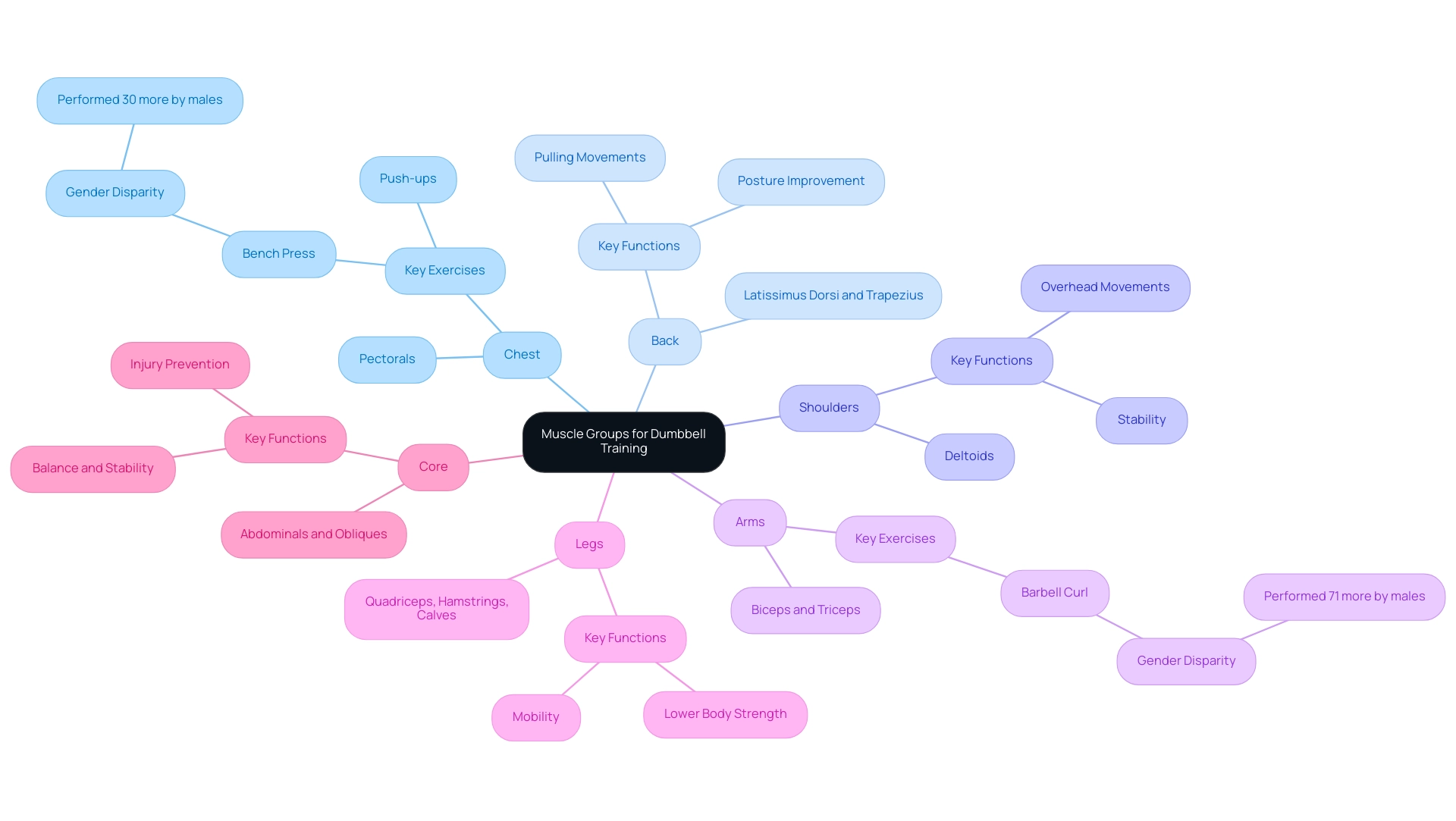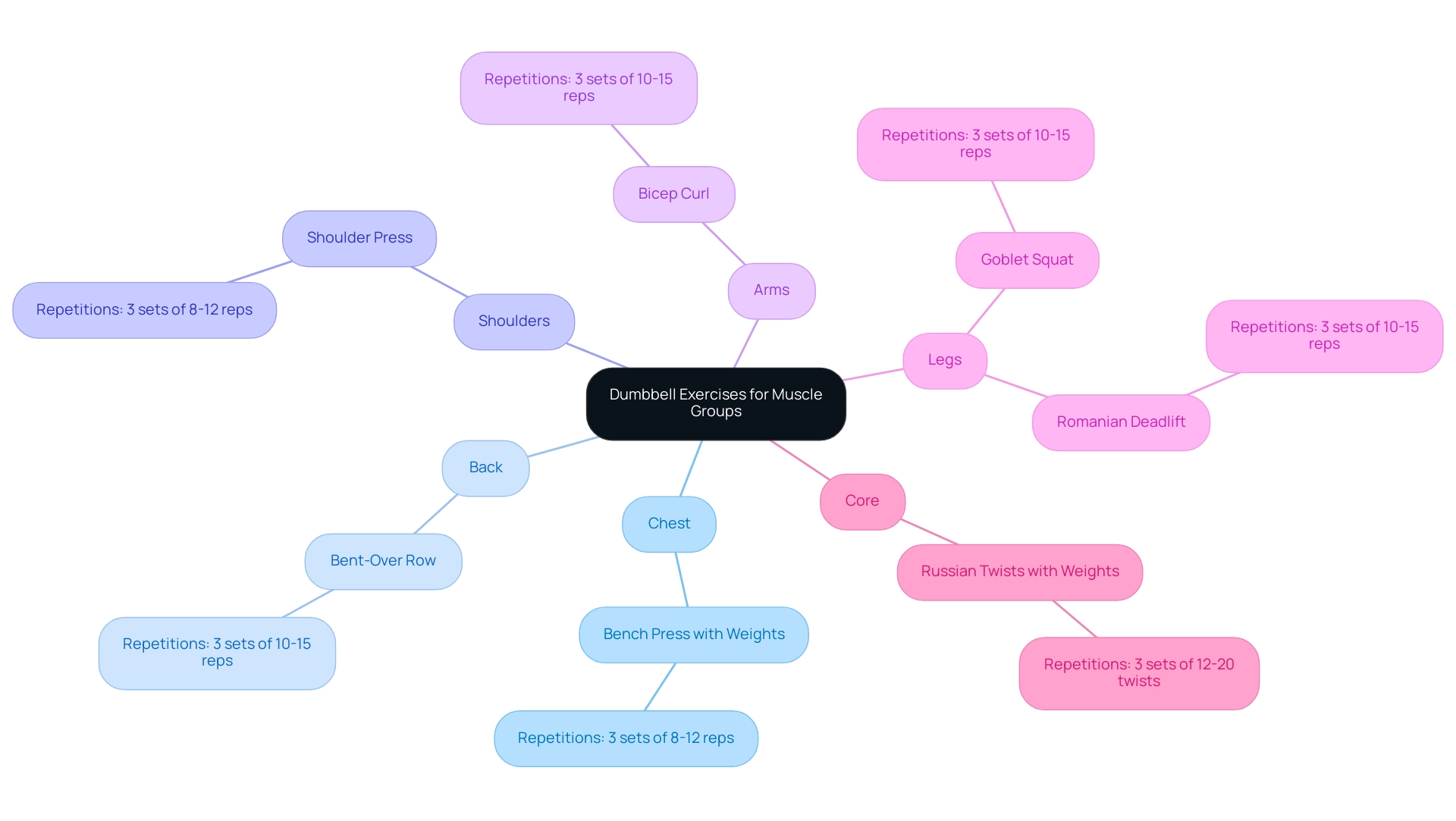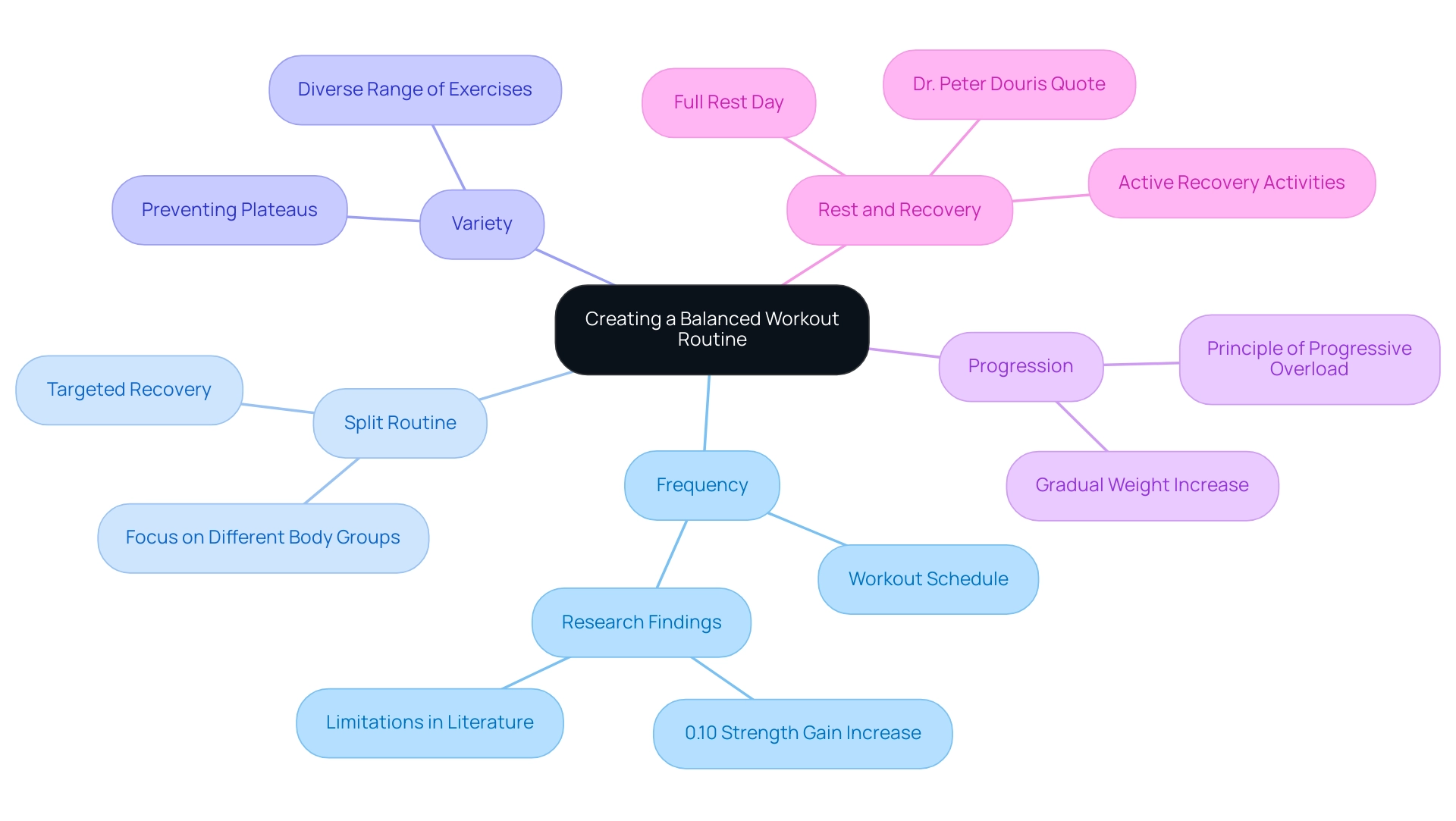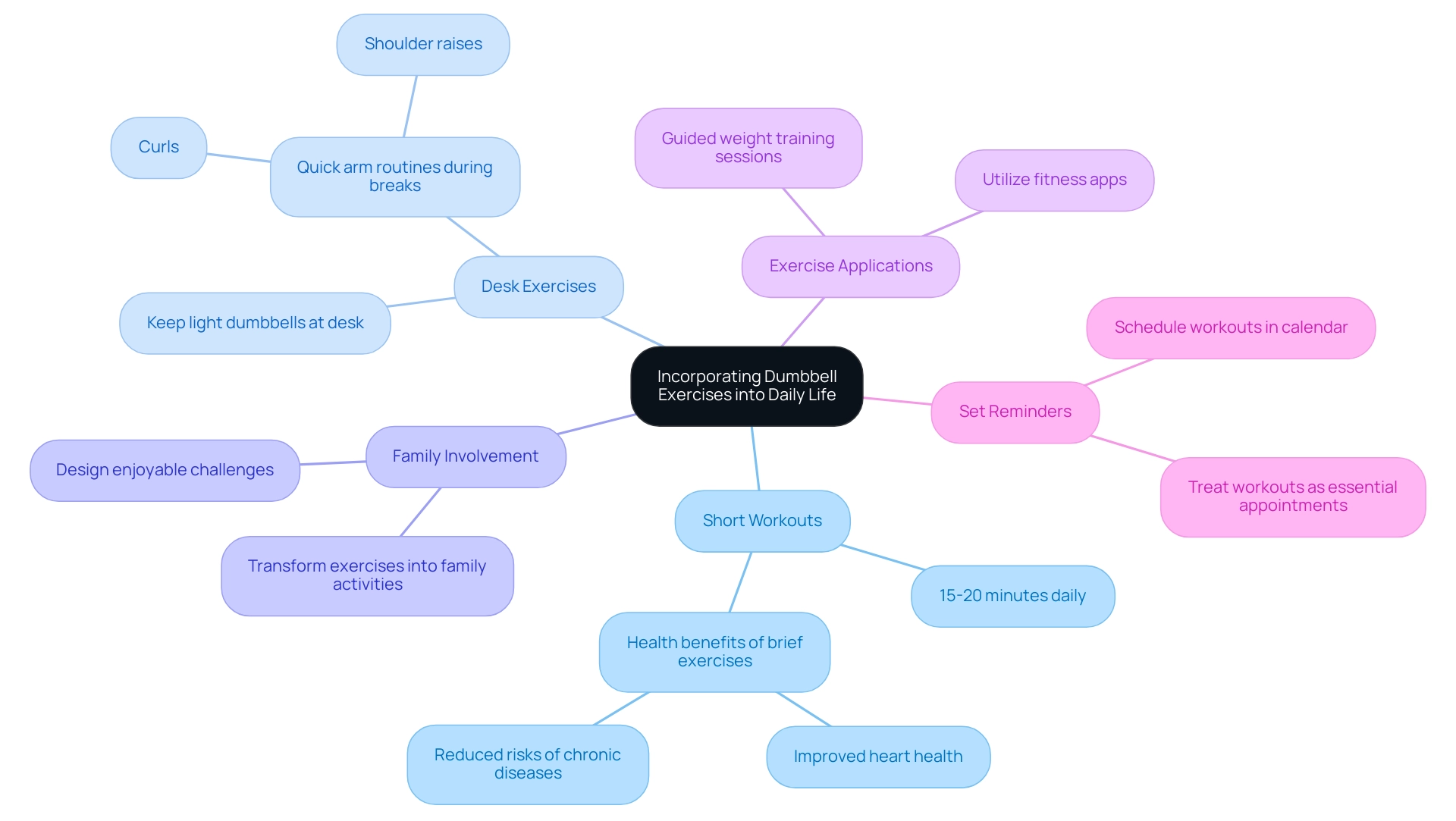Introduction
In the pursuit of optimal health and fitness, understanding the intricacies of muscle groups is paramount for anyone looking to elevate their strength training regimen. This article delves into the essential components of effective dumbbell training, offering insights into the primary muscle groups and their respective functions, as well as targeted exercises to enhance overall performance.
By emphasizing the importance of a balanced workout routine and the integration of practical strategies into daily life, readers will discover how to foster a culture of wellness that not only benefits individual fitness journeys but also uplifts team spirit and productivity.
With actionable tips and research-backed recommendations, this guide serves as a valuable resource for those ready to take charge of their health and inspire others along the way.
Understanding Muscle Groups for Effective Dumbbell Training
Maximizing the benefits of your dumbbell training starts with a solid understanding of the dumbbell exercises for each muscle group you aim to target. Here’s a breakdown of the major muscle groups and their critical functions:
- Chest (Pectorals): This muscle group is key for pushing movements, such as bench presses and push-ups, and strengthening the chest can significantly enhance upper body strength, vital for overall fitness. Notably, the bench press is performed 30% more by male users than females, highlighting differences in exercise habits.
- Back (Latissimus Dorsi, Trapezius): Essential for pulling movements and promoting good posture, a strong back can alleviate strain on the spine, contributing to a healthier and more functional body.
- Shoulders (Deltoids): Important for overhead movements and stability, robust shoulders enhance performance in various sports and daily tasks, making them integral to an effective exercise program.
- Arms (Biceps and Triceps): Crucial for elbow flexion and extension, targeting these areas not only improves functional strength for lifting and carrying but also contributes to overall arm aesthetics and performance. The barbell curl, for instance, is performed 71% more by male users than females, reflecting a gender disparity in training focus.
- Legs (Quadriceps, Hamstrings, Calves): These groups form the foundation of lower body strength and mobility. Strong legs support overall body mechanics, vital for athletic performance and daily activities.
- Core (Abdominals and Obliques): The core is central to maintaining balance and stability. A strong core supports all movements, reducing the risk of injury and enhancing overall performance.
Comprehending these groups of tissues allows you to design a balanced workout routine that incorporates dumbbell exercises for each muscle group, encouraging overall strength and health. However, it's crucial to manage exercise volume carefully, as higher workout frequencies can increase the risk of overreaching or overtraining. Recent studies suggest that exercising each group of tissues a minimum of twice a week is crucial for optimizing growth, with frequency enhancing hypertrophy by 0.11% for every additional workout day.
As Schoenfeld BJ highlights,
the major muscle groups should be trained at least twice a week to maximize muscle growth.
Furthermore, insights from the case study titled "Effects of the Ketogenic Diet on Strength Performance in Trained Men and Women" suggest that dietary choices can significantly impact strength performance results. This knowledge empowers you to design effective training plans that prioritize your team's well-being and performance.

Targeted Dumbbell Exercises for Each Muscle Group
To build a well-rounded fitness routine, incorporating dumbbell exercises for each muscle group is essential. A collection of 15- to 30-pound weights is suggested for versatility. Here are some powerful movements that can elevate your strength training regimen:
-
Chest: Bench Press with Weights - Lie flat on a bench, holding a weight in each hand at chest level. Press the weights upward until your arms are fully extended, then lower them with control.
- Repetitions: 3 sets of 8-12 reps.
-
Back: Bent-Over Row - Hinge at your hips while holding a weight in each hand. Pull the weights towards your waist, focusing on squeezing your shoulder blades together as you lift.
- Repetitions: 3 sets of 10-15 reps.
-
Shoulders: Shoulder Press - Stand or sit with a weight in each hand at shoulder height. Press the weights overhead until your arms are fully extended, then return to the starting position.
- Repetitions: 3 sets of 8-12 reps.
-
Arms: Bicep Curl - Stand with a weight in each hand at your sides. Curl the weights towards your shoulders, keeping your elbows tucked close to your body.
- Repetitions: 3 sets of 10-15 reps.
-
Legs:
- Goblet Squat - Stand with your feet shoulder-width apart, holding a weight close to your chest. Lower your body into a squat while maintaining a proud chest and ensuring your knees stay behind your toes.
- Repetitions: 3 sets of 10-15 reps.
- Romanian Deadlift - Stand with your feet hip-width apart, holding dumbbells in front of your thighs. Hinge at your hips to lower the weights down the front of your legs, keeping a slight bend in your knees.
- Repetitions: 3 sets of 10-15 reps.
- Goblet Squat - Stand with your feet shoulder-width apart, holding a weight close to your chest. Lower your body into a squat while maintaining a proud chest and ensuring your knees stay behind your toes.
-
Core: Russian Twists with Weights - Sit on the floor with your knees bent, holding a weight with both hands. Lean back slightly and twist your torso to each side, tapping the dumbbell on the ground for added engagement.
- Repetitions: 3 sets of 12-20 twists.
As Amanda Capritto, a certified personal trainer, states, "Incorporating dumbbell exercises for each muscle group into your fitness routine will not only enhance your overall strength but also promote team well-being." Focus on maintaining proper form, and as you progress, gradually increase your weights for optimal results. Remember, consistency is your greatest ally in achieving those fitness goals!

Creating a Balanced Workout Routine
Establishing a balanced exercise routine is essential for promoting overall well-being and strength in your team. By customizing corporate wellness initiatives that improve employee health and productivity through personalized assistance and expert-designed exercises, you can motivate your workforce to flourish. Our customized app is a key component, providing ongoing guidance and support right in your team's pockets.
Here are some key guidelines to help you design an effective program:
-
Frequency: Strive for a workout schedule of at least 3-4 times per week. This permits sufficient rest days between sessions, promoting optimal recovery and growth.
Research indicates that each additional day of frequency can enhance weekly strength gains for lower body exercises by 0.10%, highlighting the importance of consistency. However, it is crucial to note that the current literature has limitations in establishing a clear relationship between increased frequency and strength due to methodological inconsistencies in resistance training studies.
-
Split Routine: Implement a split routine by concentrating on different body groups on separate days.
For example, dedicate one day to upper body workouts and another to lower body exercises. This method not only optimizes engagement but also allows for targeted recovery, ensuring employees feel energized and ready to tackle their tasks.
-
Variety: Incorporate a diverse range of exercises for each body group to maintain engagement and prevent plateaus.
For instance, alternate between dumbbell bench presses and push-ups for chest workouts. This variation keeps routines fresh and exciting, motivating participants to stay committed to their health journey.
-
Progression: Embrace the principle of progressive overload by gradually increasing the weights as strength improves.
This method is essential for ongoing growth and development, ensuring that your team observes tangible results from their efforts. Remember, investing in their fitness is investing in your firm’s success.
-
Rest and Recovery: Prioritize recovery by scheduling at least one full rest day each week.
Active recovery days featuring light activities like walking or stretching can also aid in the recovery process. Dr. Peter Douris notes that no significant differences were observed in strength changes between training once a week versus twice a week over nine weeks, underscoring the necessity of allowing time for recovery. This highlights the importance of balancing workout frequency with adequate recovery, a theme that is essential to consider when designing effective workout routines that incorporate dumbbell exercises for each muscle group. By adhering to these guidelines, you can cultivate a workout routine that effectively targets all muscle groups while keeping your team inspired and engaged on their fitness journey.
Moreover, regular exercise not only enhances physical health but also boosts cognitive performance, leading to improved job performance, creativity, and stress management. With current trends in fitness routines emphasizing the importance of frequency and variety, now is the time to take action and prioritize your team's health. Additionally, utilizing statistical methods and meta-analysis techniques can enhance the credibility of your recommendations, ensuring they are grounded in reliable research.

Incorporating Dumbbell Exercises into Daily Life
Incorporating dumbbell exercises for each muscle group into your daily life can be straightforward and rewarding. Here are some practical tips to help you get started:
-
Short Workouts: Commit to just 15-20 minutes of focused weight training each day.
Research shows that even brief, consistent sessions can yield significant health benefits, including improved heart health and reduced risks of chronic diseases. In fact, a 15-year study involving over 55,000 Americans found that engaging in just five to ten minutes of exercise per day is associated with markedly reduced risks for all causes of death.
-
Desk Exercises: Keep light dumbbells at your desk for quick arm routines during breaks.
Simple moves like curls and shoulder raises are examples of dumbbell exercises for each muscle group that can effectively engage your muscles, turning idle moments into productive ones.
-
Family Involvement: Transform exercises into a family activity by involving your children or partner.
Design enjoyable challenges or fitness activities that include weights, turning exercise into a delightful and communal experience.
-
Exercise Applications: Utilize fitness apps that provide guided weight training sessions customized to your requirements.
These tools can keep you motivated and accountable, especially on busy days.
-
Set Reminders: Treat your workout sessions as essential appointments by scheduling them in your calendar.
This practice emphasizes the significance of fitness in your daily schedule.
By incorporating these strategies into your life, you can make weightlifting, particularly through dumbbell exercises for each muscle group, a regular and enjoyable element of your routine, ultimately improving your overall health and well-being. Remember, as Scott J. Strath, Ph.D., emphasizes, prioritizing even short bouts of exercise can lead to substantial long-term health benefits, particularly in promoting heart health.

Tracking Progress and Staying Motivated
To effectively monitor your progress and sustain motivation in your weight training journey, consider the following empowering strategies:
-
Set SMART Goals: Establishing goals that are Specific, Measurable, Achievable, Relevant, and Time-bound is essential. For instance, you might set a target to increase your bench press weight by 5 pounds over the next four weeks. Being specific clarifies what you want to achieve, measurable allows you to track your progress, achievable ensures your goal is realistic, relevant ties the goal to your overall fitness objectives, and time-bound provides a deadline for your goal. This structured approach not only clarifies your objectives but also enhances your focus on achievement.
-
Keep a Workout Journal: Documenting your exercises, weights, and repetitions is a powerful way to visualize your progress over time. By reviewing your entries, you can witness your improvements, which serves as a constant source of motivation. As Ryan DeLuca, CEO of Bodybuilding.com, noted,
We created this Challenge three years ago as a way to help people get started and to put those pieces together. It has changed lives, and we are excited to see the transformations this New Year brings.
Your journal can be a similar catalyst for change.
-
Take Progress Photos: Capturing your physical changes through regular photos can provide compelling visual evidence of your hard work and dedication. Seeing your transformation over the weeks can be incredibly motivating and serve as a reminder of your commitment to fitness.
-
Celebrate Milestones: Recognizing and celebrating your achievements, no matter how small, is crucial for maintaining motivation. When you reach a goal, treat yourself to something enjoyable—a new workout outfit or a special meal—as a reward for your hard work.
-
Join a Community: Engaging with fitness communities, whether online or in-person, creates a supportive environment where you can share your experiences and receive encouragement. The collective motivation from others can significantly enhance your own commitment to your training.
Incorporating research-backed insights, studies from the National Cancer Institute emphasize the importance of goal-setting in health behavior change. For example, a case study titled 'Impact of Goal-Setting on Dietary Intake' found that goal-setting could significantly improve dietary intake among older adults, illustrating the broader implications of establishing clear goals for health improvement. By implementing these strategies, you'll not only track your progress effectively but also cultivate a lasting motivation that supports your long-term success and well-being in performing dumbbell exercises for each muscle group.
![]()
Conclusion
Maximizing the benefits of dumbbell training hinges on a thorough understanding of muscle groups, effective exercise techniques, and a commitment to a balanced workout routine. By targeting key muscle groups such as:
- Chest
- Back
- Shoulders
- Arms
- Legs
- Core
individuals can develop a comprehensive fitness regimen that enhances strength and performance. Incorporating specific exercises for each muscle group ensures that every aspect of fitness is addressed, while maintaining proper form and consistency is crucial for achieving desired results.
Emphasizing the importance of frequency, variety, and progression in workout routines further supports the goal of building strength and improving overall well-being. By creating a structured plan that includes adequate recovery and actively engaging in daily life through short workouts or desk exercises, individuals can seamlessly integrate fitness into their routines. This not only fosters personal health but also cultivates a culture of wellness within teams, enhancing productivity and morale.
Ultimately, the journey toward optimal health is not just about individual gains; it’s about inspiring others to prioritize their fitness and well-being. By tracking progress, setting achievable goals, and celebrating milestones, everyone can stay motivated and committed to their health journey. Now is the time to take action, invest in fitness, and create an environment where health and performance thrive.




